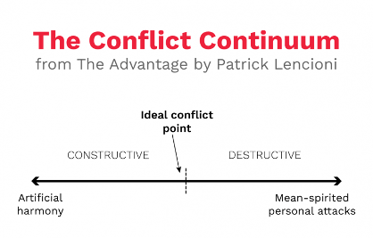You're wrapping up a meeting with your leadership team, and you have a feeling that one or two of the people present are feeling uncomfortable – maybe they're even downright seething. You couldn't have gotten this far in your career without being able to read a room and know something is off.
But do you know what the problem is? Nope. There were a few weighty decisions and controversial issues on the agenda today, and you have a guess at who might have objections to one or the other. But the team members in question didn't speak up, and apparently, they don't intend to.
It's choose-your-own-adventure time. You can:
- Ignore the simmering tension, pretend that silence equals agreement, and move on with your fingers crossed that this won't resurface down the line.
- Drill the team members in question with a scowl and a firm "Okay, what's YOUR problem?" Because, hey, that's never failed before…
- Retreat to your office to create an elaborate map of each team member's possible issues with any of the topics discussed in today's meeting and rework the plan based on that entirely hypothetical feedback.
We sincerely hope that the teams you manage have a healthier approach to conflict than the folks described above, but we're willing to bet this situation sounds at least a bit familiar. After all, who among us can claim to be perfectly comfortable and balanced when addressing tension and disagreement, especially in high-stakes professional settings?
Starting from a place of trust
Patrick Lencioni's ambitious and comprehensive guide to organizational health, The Advantage, tackles the topic of healthy conflict as one of the elements necessary for building a cohesive leadership team. The first step, he argues, is to build trust. Here's a quick breakdown of his tips for creating a culture of trust within your leadership team:
- Lean into being vulnerable.
- Share your personal histories.
- Engage, as a group, with some behavior profiling tools (Myers-Briggs Type Indicator, CliftonStrengths, etc.).
- Seek to understand more than to be understood (Franklin Covey Habit 5).
Once that trust is established, you're safe to let those conflicts out into the open.
Interested in more resources geared toward building trust within your team? Check out some key points from David Horsager's Trusted Leader.
"When there is trust, conflict becomes nothing but the pursuit of truth, an attempt to find the best possible answer."
- Patrick Lencioni, The Advantage
The Conflict Continuum
 Lencioni uses the continuum to visualize how teams and individuals tend to approach conflict. There's avoidance for the sake of artificial harmony, a destructive "attack mode" that's just plain mean, and a sweet spot somewhere in between, where healthy, constructive conflict and dialogue can take place.
Lencioni uses the continuum to visualize how teams and individuals tend to approach conflict. There's avoidance for the sake of artificial harmony, a destructive "attack mode" that's just plain mean, and a sweet spot somewhere in between, where healthy, constructive conflict and dialogue can take place.
Ask yourself:
- What are YOUR personal inclinations when it comes to engaging with conflict? Do you tend to avoid addressing issues or come in swinging?
- How does your leadership team currently engage with conflict? Which side of the spectrum does the group drift towards?
- Are there any decisions or issues your team is currently working through that may require a little more productive conflict?
Your conflict-engagement toolbox
When teams are set up to trust one another, and conflict becomes a healthy and necessary process, Lencioni recommends leaning into a few key steps:
Mine for conflict. Give that pot a (gentle) stir. Prod someone directly (and respectfully). Start a (productive) fight. What disagreement are you sensing below the surface, and how could you bring it out in the open?
Give real-time permission. Express appreciation once productive conflict begins to occur. Think carefully about how to phrase your acknowledgment and gratitude for the courage it takes to engage openly in disagreement – even a casual, "Yes – THIS is what we needed!" can do the trick.
Set clear guidelines and expectations around conflict. Thinking about your team's tendencies to either avoid or overdo conflict, what explicit guidelines would be helpful? Do you all share an understanding of what silence means – about what tones and phrases might cross the line? Do you ask each team member for verbal commitment at the end of a discussion?
Now that you've determined there's value in engaging with conflict and sitting with discomfort, get to it! Go stir that pot and watch your team rise to the occasion.
Need more practical resources for approaching tough conversations?
Take a look at our ebook focused on effective confrontation strategies.


Comments